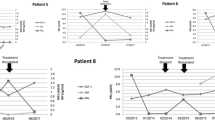Abstract
It has been suggested in the past that some normoprolactinemic patients with amenorrhea or infertility respond to treatment with bromocriptine. However, the beneficial effect of this therapy in normoprolactinemic women remains controversial. Some authors have suggested that the responders suffer with “reactive” hyperprolactinemia and that this may be detected with thyrotropin releasing hormone (TRH) stimulation. In this study, we performed TRH stimulation tests in 538 patients with ovulatory dysfunction. Only those patients showing a peak prolactin response after TRH which exceeded 40 ng/ml were treated with bromocriptine. A direct correlation between peak prolactin level after TRH and a favorable response to treatment was observed. Serum testosterone and DHEA-sulfate levels did not correlate with prolactin response to TRH. A majority of patients with prolactin hyperresponse to TRH did not show a hyperresponse of TSH to TRH. This study suggests that incidence of beneficial response to bromocriptine therapy in normoprolactinemic women with ovulatory dysfunction is significantly higher in subjects exhibiting excessive prolactin response to TRH stimulation.
Similar content being viewed by others
References
Crosignani P.C., Reschini E., Lombroso G.C., Arosio M., Peracchi M. Comparison of placebo and bromocriptine in the treatment of patients with normoprolactinemic amenorrhea. Br. J. Obstet. Gynecol. 85: 773, 1975.
Corenblum B., Taylor P.J. A rationale for the use of bromocriptine in patients with amenorrhea and normoprolactinemia. Fertil. Steril. 34:239, 1980.
Seibel M.M., Oskowitz S., Kamrava M., Taymor M.L. Preliminary observations on the response to low-dose bromocriptine in normoprolactinemic patients with polycystic ovarian disease. Obstet. Gynecol. 64: 213, 1984.
Del Pozo E. Management of borderline hyperprolactinemia. Horm. Res. 22:204, 1985.
Padilla S.L., Person G.K., McDonough P.G., Reindollar R.H. The efficacy of bromocriptine in patients with ovulatory dysfunction and normoprolactinemic galactorrhea. Fertil. Steril. 44:695, 1985.
Peilion G., Vinceno F., Cesselin F., Doumith R., Mowszowicz I. Exaggerated prolactin response to thyrotropin-releasing hormone in women with anovulatory cycles: possible role of endogenous estrogens and effect of bromocriptine. Fertil. Steril. 37:530, 1982.
Utiger R.D. Test of thyroregulatory mechanisms. In: Ingbar S.H., Braverman L.E. (Eds.), Werner’s The Thyroid, A Fundamental and Clinical Text. J.B. Lippincott, New York, 1986, p. 511.
Author information
Authors and Affiliations
Rights and permissions
About this article
Cite this article
Steinberger, E., Nader, S., Rodriguez-Rigau, L. et al. Prolactin response to thyrotropin-releasing hormone in normoprolactinemic patients with ovulatory dysfunction and its use for selection of candidates for bromocriptine therapy. J Endocrinol Invest 13, 637–642 (1990). https://doi.org/10.1007/BF03349585
Received:
Accepted:
Published:
Issue Date:
DOI: https://doi.org/10.1007/BF03349585




